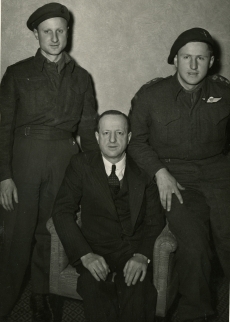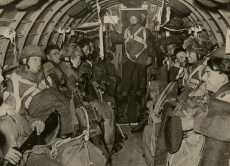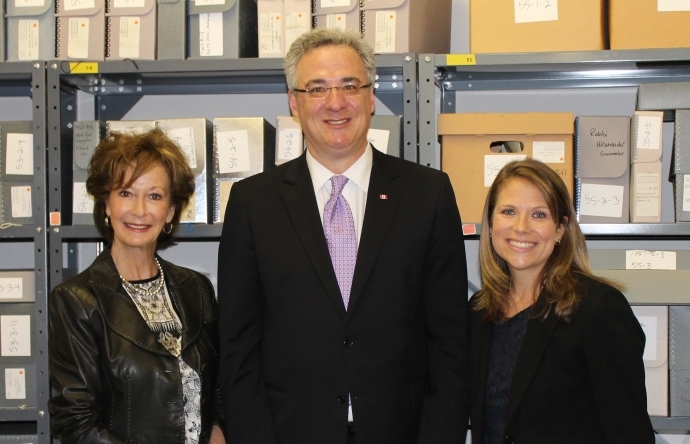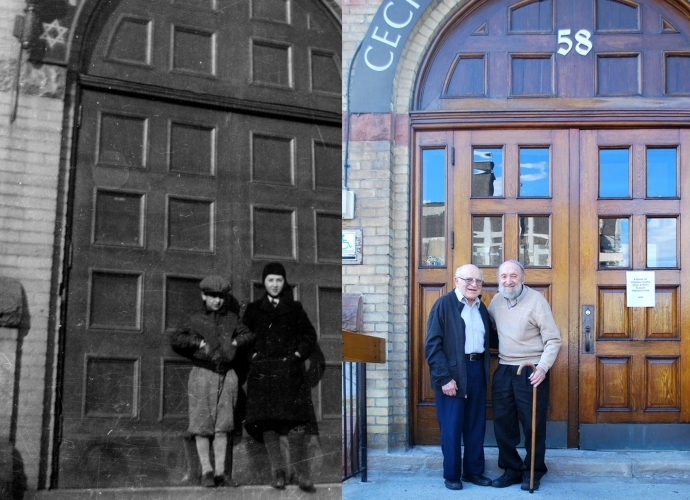Why is this night different than all other nights?
Celebrating Passover at the Ontario Jewish Archives, Blankenstein Family Heritage Centre
For decades, Passover has been the most widely celebrated holiday on the Jewish calendar. And, the sheer volume of Passover-related records in the collection of the Ontario Jewish Archives, Blankenstein Family Heritage Centre is evidence of this phenomenon. There is a wide variety of Passover-related material from both private and institutional records.
![Passover Seder at Fort Brady (Sault Ste. Marie, Michigan), [ca. 1942]. Ontario Jewish Archives, item 4819. Passover Seder at Fort Brady (Sault Ste. Marie, Michigan), [ca. 1942]. Ontario Jewish Archives, item 4819.](https://ontariojewisharchives.org/cms_uploads/images/4819-copy2.jpg) There are a number of photographs of large-scale Seders organized for Jewish servicemen and women during the Second World War. This photo is from a Seder held at Fort Brady military base in Sault Ste. Marie, Michigan in 1942. It was attended by military personnel from both the United States and Canada and Rabbi Fishman of Congregation Beth Jacob in Sault Ste. Marie, Ontario led the Seder. Canadian Winston Rubinoff attends a 1943 Seder for army personnel at the Balfour Club near Trafalgar Square in London, England. There are also photographs of a Seder in Prince George, British Columbia on April 3, 1944, also for military personnel.
There are a number of photographs of large-scale Seders organized for Jewish servicemen and women during the Second World War. This photo is from a Seder held at Fort Brady military base in Sault Ste. Marie, Michigan in 1942. It was attended by military personnel from both the United States and Canada and Rabbi Fishman of Congregation Beth Jacob in Sault Ste. Marie, Ontario led the Seder. Canadian Winston Rubinoff attends a 1943 Seder for army personnel at the Balfour Club near Trafalgar Square in London, England. There are also photographs of a Seder in Prince George, British Columbia on April 3, 1944, also for military personnel.
In the collection are records documenting the very meticulous preparation required for the holiday. Included are contracts for the sale of chametz in accordance with the restriction of eating "leaven" -- any food that's made of grain and water that has been allowed to ferment and “rise” during Passover. This includes bread, cereal, cake, cookies, pizza, pasta, and beer. In the records of community leader Solomon Edell, a pharmacist, we find contracts that permitted him to sell chametz in his pharmacy during Passover. A Passover Kashruth seminar organized by COR was held at the Shaarei Shomayim Synagogue in 1982.
Preparation of the holiday also includes the baking of the matzah and we have a wonderful collection of photographs from the 1940s opening of the Gula Matzah Factory on Monarch Road in Toronto’s Junction area in 1948. The photographs include leaders from the Orthodox community watching in awe as the machines churn out the matzah on an assembly line.
There are also photographs of Seders held by families around the province of Ontario—north, south, east and west—the Dubinsky family of Kirkland, a model Passover Seder at the Beth David Synagogue in Brantford; the Davidson family Seder in 1912 in Burks Falls. Eddie and Brian Greenspan describe their family Seders in Niagara Falls, Ontario in a recorded oral history.
The OJA documents community-organized Passover initiatives that demonstrate how the holiday’s relevance is renewed each year by recognizing and helping those who are still unable to practice religious freedoms in their countries. During the 1960s, the Central Region of the Canadian Jewish Congress began sending relief shipments to Cuban Jews unable to acquire kosher foods for Passover. The National Council of Jewish Women also organized Passover food drives in Toronto.
In 1986 the Committee for Soviet Jewry, part of the Canadian Jewish Congress, organized a Passover Poster Contest for Hebrew Day School students that raised awareness around the plight of the Refuseniks unable to leave the Soviet Union. And, in 1990 the UJA’s Walk for Israel created a special Operation Exodus Haggadah for Passover which included a fifth question to be asked at Passover Seders that year. The answer:
“As we observe this festival of freedom we are heartened to be part of the largest exodus of soviet Jews in recent history. For decades Soviet Jews resisted suppression with faith. Struggling to live as Jews, many sought valiantly to leave for Israel, the land of redemption. Many suffered harassment and some endured prison…. At last, many are allowed to go free. We walk with them in their exodus. At our Seder, we commit ourselves to accompany our fellow Jews on their road to freedom, pledging the assistance they require now and in the future, for we do not know how long the door of freedom will remain open.” (Fonds 67: 17-1-16)
Check out our Facebook Page during Passover to see many of the photos mentioned here.
Share your Passover stories and photos. To donate material, email: ojadonations@ujafed.org
From all of us at the Ontario Jewish Archives, Blankenstein Family Heritage Centre, we wish you and your families a very healthy and happy Passover. Chag Sameach!



